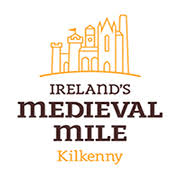As you enter the Main Hall of Kilkenny Castle today one of the most striking portraits on display on the right hand side is of James Butler (1774 -1838) 1st Marquess (3rd creation), 19th Earl of Ormonde and Chief Butler of Ireland. In the portrait, the Marquess is depicted wearing a heavy dark coat draped over his shoulder and just visible beneath the coat is the blue ribbon of the Order of St. Patrick. Overall, the pose is highly romantic and heroic, fashionable with portraits of this period. It is very similar to the portrait attributed to Rothwell of Daniel O’ Connell in Derrynane House and the muscularity and poise of the sitter bring to mind the romantic portraits of Lord Byron and the Romantic poets of the period.
The artist is an Irish born painter called Richard Rothwell R.H.A. (1800 – 1868). Rothwell was born in Athlone the eldest of seven children of James Rothwell and his wife Elizabeth Holmes. At the age of fourteen his uncle, Thomas Watson ad him entered in the Dublin Society School to begin his art studies. There he developed considerable skill as a draughtsman and in in 1820 he was awarded a silver medal for his studies in oil. He then began his career as a portrait painter although he had to be strongly persuaded from not joining a company of strolling players, thus showing perhaps some of his romantic temperament. On the foundation of the Royal Hibernian Academy in 1823, he was elected an Associate and the following year a Member. In 1829 he arrived in London and he became a success almost overnight. Landseer wrote, “An artist has come from Dublin who paints flesh as well as the Old Masters”. Rothwell was to join the studio of the great English portrait artist Sir Thomas Lawrence and upon Lawrence’s death; Rothwell was entrusted with the finishing of his uncompleted portraits. Despite finding success in London Rothwell decided to visit Italy in 1831 and on his return to London in 1835 he discovered that he had become forgotten and other artists had taken his place in his absence abroad. In 1847, depressed and discouraged by lack of patronage he returned to Ireland and settle at Rose Cottage in Rathfarnham with his wife and family. Tragically, he lost his eldest child and became unsettled; the child was to figure in his painting of a Madonna and Child. Later in his life, he was to travel to Boston and in 1866 was to travel to Rome. Unfortunately, while saying in Rome he was to catch a fever and after a week’s illness, he died on 13th September 1868.
Rothwell, although in his early life seemed to promise a brilliant future, never found any lasting success as an artist. He was by all accounts a difficult man to get on with and was prone to take offense. His temper was often to bring him in to conflict with other artists both in Dublin and in London.
One of Richard Rothwell’s most famous portraits is located in the National Portrait Gallery in London and is of the famous English novelist Mary Shelley. It is listed as NPG 1235 and it was bequeathed to the Gallery by Mary’s sister-in-law Jane, Lady Shelley in 1899. Her most famous novel is of course Frankenstein: or, The Modern Prometheus written when she was just 18 years old. While staying with her future husband Percy at Lake Geneva in 1816 their host Lord Bryon invited his guests into a competition as who among them could write the best ghost story. Mary began the nucleus of her novel that evening and it was first published anonymously in London in 1818 and the second edition published in Paris was to have Mary Shelley listed as the author in her own right, she was just 20 years old. The loss of her first child, the death of her mother and the relationship with her father are said to been strong influences in the novel. It is a remarkable book in its prescience, concerning modern concepts like electricity or galvanism, reanimation and philosophy and the BBC lists it as one of the 100 most influential books of all time.
On a side note: while staying in Pisa, Mary and Percy Shelley became friendly with a couple known as “Mrs and Mr. Mason” which was the name adopted by Lady Mountcashell, Lady Margaret Moore and George Tighe of Rossanagh whilst living in Italy. Lady Mountcashell had become a close friend and correspondent of Mary’s mother, Mary Wollstonecraft while she was in Ireland acting as a governess to the Earl of Kingston, Robert King. While staying with the “Mason’s” Mary wrote a short story for their daughter Laurette that was only re-discovered in 1997, the year of Mary Shelly’s bicentenary.
The painting of Mary Shelly by Richard Rothwell was completed in 1840, just a year before Mary had begun to feel unwell and was later diagnosed with what was a brain tumour. The painting shows a very delicate elegant face although slightly sorrowful and haunted. It is possible that her poise is stiff due to possible discomfort with her illness. Mary was to die in February 1851 aged just 53 years at Chester Square in London.
On the anniversary of her death her children opened her box-desk and found locks of her dead children’s hair, a notebook she shared with her husband Percy, a copy of his poem Adonais with one page wrapped around a silk parcel containing some of his ashes.
Mary Shelley is better known internationally today than her husband Percy Shelly purely from the work of her earliest novel Frankenstein written again at the incredible age of just 18 years old. The creature from her novel has become one of the most iconic of images especially at Halloween each year. We very proud in Kilkenny Castle to have a small connection to this most famous of authors.
Peter Kenny
October 2022



